Relevant to ACCA Qualification Paper P4 and Performance Objectives 15 and 16
How do you answer a Paper P4 question on interest rate risk management? The purpose of this article is to show how you can maximise your marks by producing an answer that will impress the examiner and markers on a topic that has caused students significant difficulty.
We must start by understanding the examiner’s philosophy – what is expected of Paper P4 candidates? From reading previous articles and sample questions, we can identify three recurring themes:
- Exam questions have been – and will continue to be – scenario based, requiring students to demonstrate their analytical skills. The requirements have been clear and without ambiguity.
- They require candidates to apply the skills they have learned in the classroom and from textbooks to solve the issues raised. The calculations that need to be performed will be carried out under an element of time pressure – therefore, good technique is essential.
- Most importantly, to successfully pass, candidates must be able to discuss and give advice – it is not sufficient to leave the answer as a string of figures and computations lacking relevant explanations.
It is therefore clear that, as a Paper P4 candidate, you know what you have to do to pass. There can be no replacement for thoroughly studying the entire syllabus, with the emphasis on the major topics such as risk management. Revision through practising as many past exam – or exam style – questions as possible is absolutely essential. With the latter in mind, let’s consider a question on interest rate risk management and tackle it in an efficient and effective manner.
Titans FC
Titans FC is the most successful football club in the country having secured, last season, a record number of premier league titles. Success on the pitch has been matched with business success. The club has a strong financial position and a solid revenue stream generated from worldwide sales of its merchandise.
Titans is not currently listed, but there are plans to make an IPO in the near future. The Steelers family currently own s all the equity in Titans but leave the running of the club to its board and the club’s experienced team manager.
The board has, in the past, been very efficient at converting the revenues earned into cash, and Titans is cash rich with £85m in the bank as per its financial statements dated 30 September 2011. Two and half months on, Today (15 December 2011), the cash has been used to settle commitments to fellow clubs for players purchased during the last transfer window.
The team manager has approached the board with the proposal regarding the acquisition of a new player in the next transfer window, which will open in a two weeks time. The player has expressed a strong interest in joining Titans and is currently valued at £30m. Initial discussions with the player’s agent indicate that Titans will have to settle the full value with Santini AFC, the player’s current club, by the 15 March 2012. This will, he says, secure the player’s services.
The board agrees with the team manager and want to make the appropriate funds available. However, the club’s finance director has stated that the club will need a temporary loan facility from the club’s bankers for a period of two months. Cash receipts are expected to flow in at the end of the season from its foreign operations, which will then return the company to its normal surplus position.
The FD has spoken to the bankers who have agreed to provide the £30m needed. Given Titans’ credit rating, the short - term loan will be at a rate of 90 basis points above the LIBOR. Currently, LIBOR is at 6%. The bank has also suggested that, due to current economic uncertainty, LIBOR may rise by 1% or even fall by 0.5% over the coming months.
With this in mind, Titans’ board has sanctioned the FD to manage this risk in a manner he thinks will best suit Titans. The FD has obtained the following data from the money and traded derivatives markets.
Derivative contracts may be assumed to mature at the end of the month.
Three months sterling future (£500,000 contract size, £12.50 tick size)
December 93.870
March 93.790
June 93.680
Options on three months sterling futures
(£500,000 contract size, premium cost in annual %)

FRA prices:

Requirements
a. Demonstrate and explain the possible ways in which the interest rate risk may be managed using the information provided above. Advise the board of Titans on an appropriate course of action based on your analysis. (17 marks)
b. What other risks and issues should the board be aware of that may affect the purchase of the new player and the method of finance chosen? (8 marks)
(25 marks)
While there is clearly much information to digest, a well-prepared candidate must keep positive before attempting to answer the question. Before preparing the answer, there are three points to note:
- Time allocation – 1.8 minutes per mark means that we have to complete the question in 45 minutes, with 31 minutes spent on Part (a) and 14 minutes on Part (b). Time discipline should already be familiar to those sitting Paper P4, but it is especially vital for this exam.
- Understand the requirements – pick out the key words in the question. In Part (a) above, they are ‘demonstrate’, ‘explain’, ‘interest rate risk’ and ‘advise’; similarly, in Part (b), they are ‘other risks and issues’. From here, it is clear which style of answer is required and, more importantly, which area of the syllabus is being tested.
- Order of attack – it is a fallacy that many students believe that they must undertake the exam in question order and that individual elements of questions must be done in the order set. In the Paper P4 exams from the December 2010 and June 2011 sessions, I would have recommended candidates attempt Q5 first, then Q4 or Q3, Q2 and finally Q1. Also, within a question, if a latter requirement is unrelated to a former one, and appears relatively easier to do, then attempt it first.
In the above example, a candidate could attempt Part (b) first if they feel that suits them. I suggest you start each part of a question on a new page and that it is clearly labelled with a heading. This way, the marker knows which answer sheet to pull out ready to mark your script.
Part (a)
a. Timeline – I would suggest drawing and labelling this as you read through the question. The aim being to gain ‘control’ of the data.

b. Set the scene – here, I have explained briefly what is about to follow. Given the time pressure, this has to be clear and succinct.
Titans could take two strategies to manage the interest rate risk:
a. Lock the rate
b. Create a ceiling/cap
Let’s consider each in turn.
c. Lock the rate – there are two methods feasible here. The FRA is the simpler one and allows you to gain some easy marks.
FRA
i. Today – as the loan will be taken three months from today and will last for two months, the appropriate FRA is 3v5 7.08% pa. This will lock Titans into a fixed rate.
ii. 15/3 – the cash flows and final APR s will be:
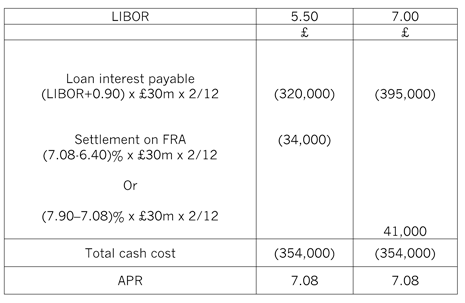
4. Financial futures – this is the alternative way of locking the rate. There are many ways of setting this out. My approach is simply to keep to three steps. The first one is to finish the timeline used earlier. A high mark scoring opportunity exists here as the principle of the converging basis risk is shown at this point.
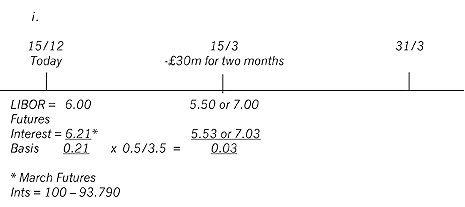
5. The Futures hedge can now set up. The examiner wants to see students’ state that this is carried out today (15 December 2011). Also, students must state if they are ‘buying’ or ‘selling’ Futures as well as showing the number of contracts. Explain as you compute is the best approach.
ii.
Today (15 December 2011), as the loan will be taken out in three months time on the 15/3, LIBOR will be most closely related to the March Futures rates. Hence, to set up the hedge, Titans will:
a. ‘Sell’ March Futures at the current rate of 9 3.790. In effect, Titans is spread betting that the March Futures interest rate will rise above (100 – 93.790) 6.21%.
b. Given contract lengths are standardised at three months, the number of contracts needed will be:
£30m/£500k x 2mths/3mths = 40
6. Margin – the question does not say to ignore margin requirements. Mention it and you will earn at least one mark.
ii. Titans would also have to pay a deposit (margin) to be held on the market for the period of the hedge. This is cash flow issue for Titans, but it is not a cost for this hedge.
7. Close out the future – the same ‘columnar’ layout can be used as per the FRA. Look carefully at the computation of the profit and loss on the Futures and the APR.
iii.
15/3 – the cash flows and final APR s will be:
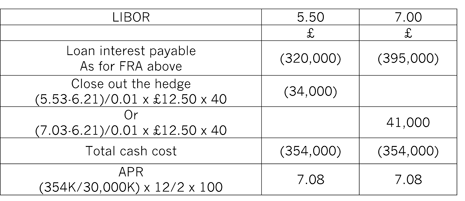
8. Option – efficiency is the name of the game here. Again, my preference is to keep it to three steps. The timeline step is simply a reference to an earlier part of the answer. The set up – explain which options are chosen and why.
CAPPING THE RATE
Traded options
i. Timeline – as above
ii. Today – there are various ways in which Titans can choose a rate at which to cap the interest rate. One method is to choose an Option, which caps the value at the current LIBOR of 6 %. This will be a MARCH PUT AT 94.000.
The number of contracts will be as for Futures – 40
Premium payable now is:
0.255% x 40 x £500,000 x 3/12 = £12,750.
This is non-refundable and is, hence, a cost of using options.
9. You will notice above that I have chosen to cap at 6 % but the texts will show other ways to choose the rate. Remember, you are under time pressure. Deliver a well-explained answer within the allocation, not a perfect one outside of the time allowed.
Here is the close out.
iii. 15/3 – the cash flows and final APR s will be:
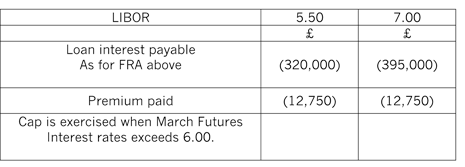
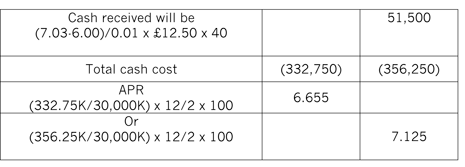
10. The examiner wants you to advise Titans on what is the best course of action for the club. This should be based upon what you have produced in your computations and you will be awarded marks accordingly.
ADVICE

Titans FC only needs the credit facility for a short period of time. Locking the rate will provide the company with certainty. It will know what the cash cost of the loan will be and can plan accordingly. The FRA has the edge over the Futures as there is no margin due.
However, the Options will provide Titans with an element of flexibility should rates fall. There is a cost for this, which is the non-refundable premium. Titans may choose to reduce this cost by selecting to cap at a higher rate than 6.00% or creating a collar. The latter will involve the entity sacrificing some benefits if rates fall below the floor level.
Recommendation will be to use the FRA given the certainty it provides and short-term period of the hedge.
11. If you have not completed the computations make your comments in general terms. Credit will be given.
12. Finally, let’s turn to Part (b). Like I mentioned above, this could have been attempted before Part (a). I have used the information in the scenario along with some common business sense to derive my points.
Part (b)
There are several additional risks/issues Titans need to be aware of regarding this transaction and method of finance.
i. There is no certainty the player will sign. Other bids may come in from rival clubs and he may join one of them.
ii. £30m is an indicative value and not the final amount. The final price may well be higher (or lower) than this amount.
iii. Paying the full value for the player by 15 March 2012 may ‘ sweeten the deal’, but is not sensible. It would be more logical to spread the cost over a longer period of time. May be the total fee should be linked to the player’s performance for Titans.
iv. Agent’s fees have not been included and these need to be quantified. Also, a player worth £30m is likely to command a large salary. Titans need to ensure this has been budgeted for.
v. Titans plan s to repay the loan from its foreign income due at the end of the season. The timing of this is not certain. In addition, the cash will be received in a foreign currency. Hence, additional hedging methods will need to be considered.
Conclusion
I have already stated how it is imperative you study and understand all aspects of the Paper P4 syllabus, as well as attempting many exam-standard questions within the time allocated, which will sharpen your technique. Interest rate risk management questions are challenging, but far from being impossible.
Sunil Bhandari is a freelance Paper P4 tutor


